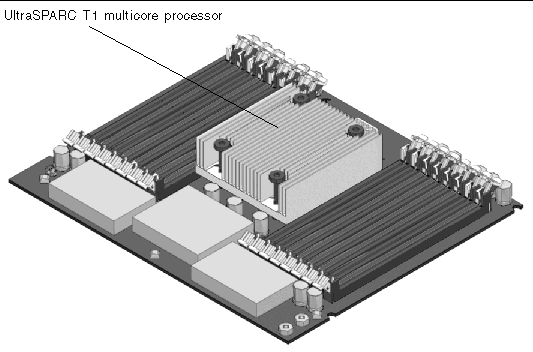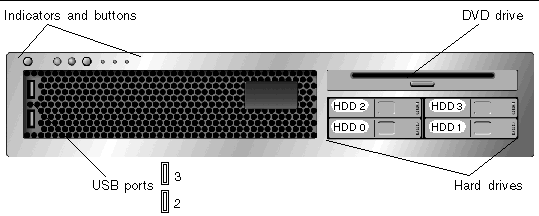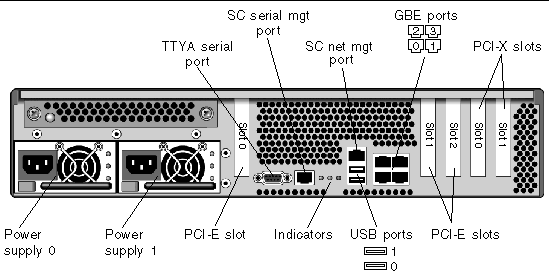| C H A P T E R 2 |
|
Server Overview |
This chapter provides an overview of the features of the server.
The following topics are covered:
The server is a high-performance entry-level server that is highly scalable and extremely reliable.

The UltraSPARC® T1 multicore processor is the basis of the server. The UltraSPARC T1 processor is based on chip multithreading (CMT) technology that is optimized for highly threaded transactional processing. The UltraSPARC T1 processor improves throughput while using less power and dissipating less heat than conventional processor designs.
Depending on the model purchased, the processor has four or eight UltraSPARC cores. Each core equates to a 64-bit execution pipeline capable of running four threads. The result is that the 8-core processor handles up to 32 active threads concurrently.
Additional processor components, such as L1 cache, L2 cache, memory access crossbar, DDR2 memory controllers, and a JBus I/O interface have been carefully tuned for optimal performance.

The server introduces several new technologies with its sun4v architecture and multithreaded UltraSPARC T1 multicore processor.
Some of these enhancements are:
TABLE 2-1 lists feature specifications for the server.
|
16 slots that can be populated with one of the following types of DDR-2 DIMMS: |
|
|
3 PCI-Express (PCI-E) slots that support[1] cards with the following specifications: 2 PCI-X slots that support* cards with the following specifications: |
|
|
2 hot-swappable and redundant power supply units (PSUs) Refer to the Sun SPARC Enterprise T2000 Server Site Planning Guide for power and environmental specifications. |
|
|
ALOM CMT management controller with a serial and 10/100 Mb Ethernet port |
|
The Sun Advanced Lights Out Manager (ALOM) CMT feature is a system controller (SC) that enables you to remotely manage and administer the server.
The ALOM CMT software is preinstalled as firmware, and it initializes as soon as you apply power to the system. You can customize ALOM CMT to work with your particular installation.
ALOM CMT enables you to monitor and control your server over a network, or by using a dedicated serial port for connection to a terminal or terminal server. ALOM CMT provides a command-line interface for remotely administering geographically distributed or physically inaccessible machines. In addition, ALOM CMT enables you to run diagnostics (such as POST) remotely that would otherwise require physical proximity to the server's serial port.
You can configure ALOM CMT to send email alerts of hardware failures, hardware warnings, and other events related to the server or to ALOM CMT. The ALOM CMT circuitry runs independently of the server, using the server's standby power. Therefore, ALOM CMT firmware and software continue to function when the server operating system goes offline or when the server is powered off. ALOM CMT monitors the following server components:
For information about configuring and using the ALOM system controller, refer to the latest Advanced Lights Out Manager (ALOM) CMT Guide.
Reliability, availability, and serviceability (RAS) are aspects of a system's design that affect its ability to operate continuously and to minimize the time necessary to service the system. Reliability refers to a system's ability to operate continuously without failures and to maintain data integrity. System availability refers to the ability of a system to recover to an operational state after a failure, with minimal impact. Serviceability relates to the time it takes to restore a system to service following a system failure. Together, reliability, availability, and serviceability features provide for near continuous system operation.
To deliver high levels of reliability, availability, and serviceability, the server offers the following features:
For more information about using RAS features, refer to the Sun SPARC Enterprise T2000 Server Administration Guide.
The server hardware supports hot-plugging or hot-swapping of the chassis-mounted hard drives, fans, power supplies, and the rear blower. Using the proper software commands, you can install or remove these components while the server is running. Hot-plug and hot-swap technologies significantly increase the server's serviceability and availability by providing the ability to replace hard drives, fan units, rear blower, and power supplies without service disruption.
The server features two hot-swappable power supplies, which enable the system to continue operating should a power supply or power sources fail.
The server also has a single hot-swappable blower unit that works in conjunction with the power supply fans to provide cooling for the internal hard drives. If the blower unit fails, the two power supply fan units provide enough cooling for the hard drive bay to keep the server running.
The server features three hot-swappable system fans. Multiple fans enable the server to continue operating with adequate cooling in the event that one of the fans fails.
The server features an environmental monitoring subsystem designed to protect the server and its components against:
Temperature sensors located throughout the server monitor the ambient temperature of the server and internal components. The software and hardware ensure that the temperatures within the enclosure do not exceed predetermined safe operating ranges. If the temperature observed by a sensor falls below a low-temperature threshold or rises above a high-temperature threshold, the monitoring subsystem software lights the amber Service Required LEDs on the front and back panel. If the temperature condition persists and reaches a critical threshold, the system initiates a graceful server shutdown.
All error and warning messages are sent to the system controller (SC), console, and are logged in the ALOM CMT log file. Additionally, some FRUs such as power supplies provide LEDs that indicate a failure within the FRU.
The UltraSPARC T1 multicore processor provides parity protection on its internal cache memories, including tag parity and data parity on the D-cache and I-cache. The internal 3 Mbyte L2 cache has parity protection on the tags, and ECC protection of the data.
Advanced ECC, also called chipkill, corrects up to 4-bits in error on nibble boundaries, as long as the bits are all in the same DRAM. If a DRAM fails, the DIMM continues to function.
The server features the latest fault management technologies. The Solaris 10 Operating System (OS), introduces a new architecture for building and deploying systems and services capable of Predictive Self-Healing. Self-healing technology enables systems to accurately predict component failures and mitigate many serious problems before they occur. This technology is incorporated into both the hardware and software of the server.
At the heart of the Predictive Self-Healing capabilities is the Solaris Fault Manager, a service that receives data relating to hardware and software errors, and automatically and silently diagnoses the underlying problem. Once a problem is diagnosed, a set of agents automatically responds by logging the event, and if necessary, takes the faulty component offline. By automatically diagnosing problems, business-critical applications and essential system services can continue uninterrupted in the event of software failures, or major hardware component failures.
FIGURE 2-3 and FIGURE 2-4 show the physical characteristics of the server.


To obtain support for your system, you need your chassis serial number. The chassis serial number is located on a sticker that is on the front of the server and another sticker on the side of the server. You can also run the ALOM CMT showplatform command to obtain the chassis serial number.
sc> showplatform SUNW,SPARC-Enterprise-T2000 Chassis Serial Number: 0529AP000882 Domain Status ------ ------ S0 OS Standby sc> |
Copyright © 2007, Sun Microsystems, Inc. All Rights Reserved.